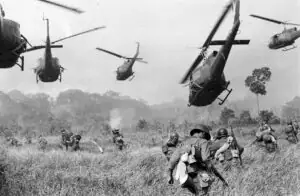When you think about the weaponry of Native American tribes, you might immediately get a picture of an old Western landscape: a lone warrior, bow and arrow in hand, poised and ready. But let’s park that image for a moment. In reality, the art of Native American armaments is not exactly what’s captured in pop culture. In fact, it’s woven with innovation, skill, and a profound connection to cultural identity.

✅ AI Essay Writer ✅ AI Detector ✅ Plagchecker ✅ Paraphraser
✅ Summarizer ✅ Citation Generator
These tools of survival and symbols of war have developed from necessity and creativity, from the prehistoric essentials found in museum exhibits to the complex designs influenced by European trade. Imagine a quiver of arrows, each with a point honed from flint or fire-hardened wood, or the war clubs and spears, not just weapons but extensions of a warrior’s spirit and skill.
The introduction of European weapons transformed Native American arsenals, producing a blend of traditional craftsmanship with new materials. Iron hatchets and knives entered the scene. They never replaced but rather became additions to the preexisting variety of bows, arrows, and spears.
But to focus on just the weapons themselves is to miss half the story. For Native American tribes, these tools weren’t only instruments of war. They were crafted with a deep sense of purpose, from hunting to ceremonial use, and each carried significance along with their practical application.
 Weapons of War and Peace: The Native American Arsenal
Weapons of War and Peace: The Native American Arsenal
Let’s cut to the chase and talk gear—the tools that Native American warriors had and used. The bow and arrow, a dynamic duo of the battlefield and the hunt were the bread and butter of all tribes. Crafted with precision, these bows were made from a mix of woods and could stretch from your average broomstick to something resembling a small tree. Arrows were no less diverse, with shafts of reed or polished wood and points that could be sharp bone, flint, or even fire-hardened wood for that extra punch.

Then you had the spears and knives. Spears weren’t just pointy sticks thrown willy-nilly. They were engineered for balance and power, the kind of weapon that demanded respect and skill. Knives were just as important, used for close-quarters defense, daily tasks, and the all-important ceremony of preparing a meal. Pretty much like our modern pocket or Swiss knives, with the only difference being that we don’t use them to stub “white men” anymore.
War clubs and tomahawks brought the boom in close combat. You might lump them all in the “club” category, but that would be like saying a smartphone is just a phone. These were carefully balanced, could be ornate or purely functional, and some, like the gunstock war club, even mocked the shape of rifles.
Materials? Think of a forest and you’re halfway there. Wood, stone, and bone were the go-tos until metal came into the picture, courtesy of European traders. Metals brought a new edge, quite literally, to weaponry, transforming arrow points and giving rise to new forms like metal-blade tomahawks.
Although “weapons,” these tools also had other purposes, probably, less important from the perspective of a “white” person, but definitely not for a native American. They were also about status, identity, and survival. Each piece told a story, from the hunts they were part of to the battles they won and the ceremonies they graced. So when you hear “Native American weapons,” think less about the tools of aggression and more about the instruments that shaped a way of life.
 The Artistry Behind the Weaponry
The Artistry Behind the Weaponry
It’s time to get a real feel for the craft behind the weapons, where every notch, feather, and curve tells you a story. Consider the blade-making process first. It wasn’t a case of whacking a rock until it looked sharp enough. No, these blades were flaked and ground with a precision that could only come from years of passed-down knowledge. And when metal entered the mix, blacksmithing skills blossomed in tribes, turning raw, traded iron into keen-edged knives and tomahawk heads.
Woodworking for bow-making was a whole other kind of wizardry. The perfect wood was always carefully selected, seasoned just right, then steamed, bent, and notched until you had a bow that could hum an arrow into the horizon. And the feather fletching on those arrows? Each one was an exercise in aerodynamics, with feathers aligned just so for the most accurate flight.

These techniques weren’t universal. The Iroquois had their own way of doing things, as did the Navajo, the Sioux, and every other tribe. And it wasn’t just about what worked best. It was a matter of available materials. Different woods, bones, and stones meant different methods.
But more than that, the diversity in craftsmanship was a language of sorts. You could read an object’s origin in the materials used, the design carved into the handle, and the type of feather on the shaft. These items were identities carved, painted, and feathered into existence. All these skills were handed down from one generation to the next and carefully preserved in all tribes. They were heritage and pride, a legacy of resilience, and a part of cultural DNA that refused to be forgotten.
 Cultural Roots of Native American Weapons
Cultural Roots of Native American Weapons
So, let’s dial down from the “how” and tune into the “why.” The weapons of Native American tribes were steeped in the spiritual, wrapped in the ritualistic, and soaked in symbolism. Each piece had its place on the battlefield and had a role in the sacred tribal identity.
Take the painted war clubs, for example. Not just any old bludgeoning tool, these clubs were canvases with intricate patterns and colors that could tell a story of a warrior’s victories or represent their spiritual journey. It’s like each club was a personal billboard advertising one’s abilities and connection to the higher powers.
Arrow-making was also far from a mundane assembly-line affair. Crafting an arrow was a meditative process, with each step having its meaning, from selecting the right feather to attaching the stone tip with sinew. And let’s not forget the blessing of the arrows—a ritual confirming that each shot was guided by the spirits.
These weapons were also markers of status. Flash a tomahawk with a handle wrapped in otter fur, and you were a person of rank, someone to be respected. These were deliberate choices that tied a warrior to their community, their ancestors, and the land itself.
And the materials were never just “the strongest” or “the sharpest.” They were the bearers of meaning—obsidian for precision and clarity, eagle feathers for courage and altitude of spirit. Even the way a weapon was held or presented during a ceremony was part of a complex language of respect and tradition.
Ultimately, these weapons were integral to the cultural life of Native American communities. They served to link tangible skills with spiritual beliefs, individual warriors with their broader society, and ancestral traditions with contemporary practices. Each weapon held a story, every shield was a testament to heritage, and every arrow bore the silent knowledge of historical people.
 From Ancient to Modern Times
From Ancient to Modern Times
Native American weapons have traveled a long path from their origins to the present day. Their influence continues, extending into modern weaponry and cultural practices. Today, these ancient arms are regarded as historical artifacts and enduring symbols of identity and heritage. They play a vital role in cultural preservation and serve as educational tools that connect younger generations to their ancestral past.
Modern interpretations of traditional weaponry can be seen in various fields. For example, the principles of balance and aerodynamics in ancient arrow design have informed contemporary archery. Similarly, the functionality and aesthetics of historical knives and tomahawks have inspired modern renditions that honor their roots while incorporating current materials and techniques.
Contemporary craftsmen and artisans remain dedicated to the art of weapon-making, often as a way to educate and reconnect with cultural practices. Through workshops and cultural programs, they pass on the knowledge of traditional methods to new learners, keeping the flame of this ancient craft alive. Ceremonial uses continue as well, with accurately recreated weapons being used in traditional dances and rituals that pay homage to the past.

In museums and cultural centers, Native American weapons are displayed to educate the public about the diverse histories of indigenous tribes. These institutions often collaborate with Native communities to make sure that the stories told are authentic and represent the significance of these items accurately.
The legacy of Native American weapons is also preserved through the stories and knowledge shared in communities. This ongoing legacy is evidence of Native cultures’ inventiveness and resiliency as well as their long-lasting influence on society.
FAQ
Follow us on Reddit for more insights and updates.





Comments (0)
Welcome to A*Help comments!
We’re all about debate and discussion at A*Help.
We value the diverse opinions of users, so you may find points of view that you don’t agree with. And that’s cool. However, there are certain things we’re not OK with: attempts to manipulate our data in any way, for example, or the posting of discriminative, offensive, hateful, or disparaging material.